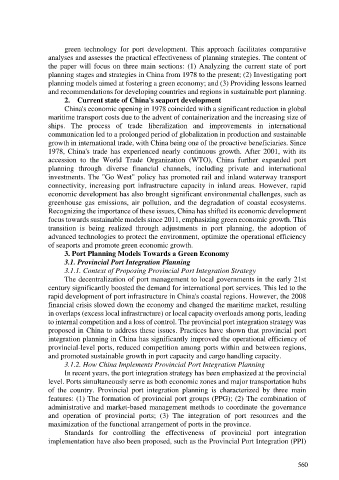Page 568 - Ebook HTKH 2024
P. 568
green technology for port development. This approach facilitates comparative
analyses and assesses the practical effectiveness of planning strategies. The content of
the paper will focus on three main sections: (1) Analyzing the current state of port
planning stages and strategies in China from 1978 to the present; (2) Investigating port
planning models aimed at fostering a green economy; and (3) Providing lessons learned
and recommendations for developing countries and regions in sustainable port planning.
2. Current state of China's seaport development
China's economic opening in 1978 coincided with a significant reduction in global
maritime transport costs due to the advent of containerization and the increasing size of
ships. The process of trade liberalization and improvements in international
communication led to a prolonged period of globalization in production and sustainable
growth in international trade, with China being one of the proactive beneficiaries. Since
1978, China's trade has experienced nearly continuous growth. After 2001, with its
accession to the World Trade Organization (WTO), China further expanded port
planning through diverse financial channels, including private and international
investments. The "Go West" policy has promoted rail and inland waterway transport
connectivity, increasing port infrastructure capacity in inland areas. However, rapid
economic development has also brought significant environmental challenges, such as
greenhouse gas emissions, air pollution, and the degradation of coastal ecosystems.
Recognizing the importance of these issues, China has shifted its economic development
focus towards sustainable models since 2011, emphasizing green economic growth. This
transition is being realized through adjustments in port planning, the adoption of
advanced technologies to protect the environment, optimize the operational efficiency
of seaports and promote green economic growth.
3. Port Planning Models Towards a Green Economy
3.1. Provincial Port Integration Planning
3.1.1. Context of Proposing Provincial Port Integration Strategy
The decentralization of port management to local governments in the early 21st
century significantly boosted the demand for international port services. This led to the
rapid development of port infrastructure in China's coastal regions. However, the 2008
financial crisis slowed down the economy and changed the maritime market, resulting
in overlaps (excess local infrastructure) or local capacity overloads among ports, leading
to internal competition and a loss of control. The provincial port integration strategy was
proposed in China to address these issues. Practices have shown that provincial port
integration planning in China has significantly improved the operational efficiency of
provincial-level ports, reduced competition among ports within and between regions,
and promoted sustainable growth in port capacity and cargo handling capacity.
3.1.2. How China Implements Provincial Port Integration Planning
In recent years, the port integration strategy has been emphasized at the provincial
level. Ports simultaneously serve as both economic zones and major transportation hubs
of the country. Provincial port integration planning is characterized by three main
features: (1) The formation of provincial port groups (PPG); (2) The combination of
administrative and market-based management methods to coordinate the governance
and operation of provincial ports; (3) The integration of port resources and the
maximization of the functional arrangement of ports in the province.
Standards for controlling the effectiveness of provincial port integration
implementation have also been proposed, such as the Provincial Port Integration (PPI)
560

